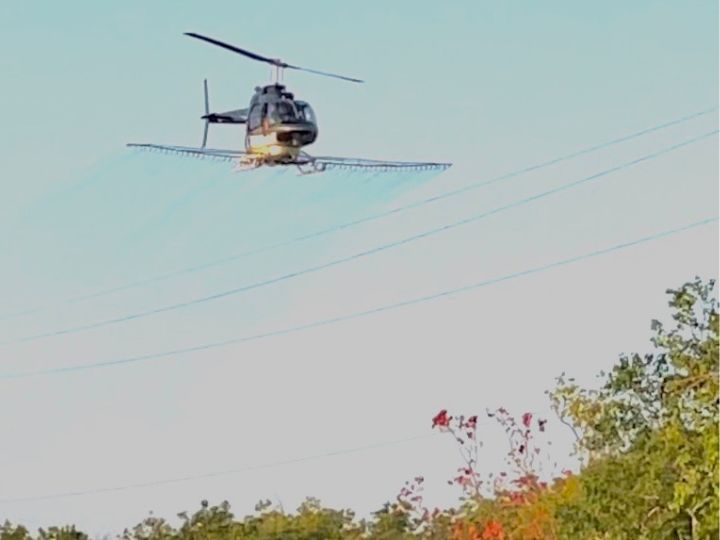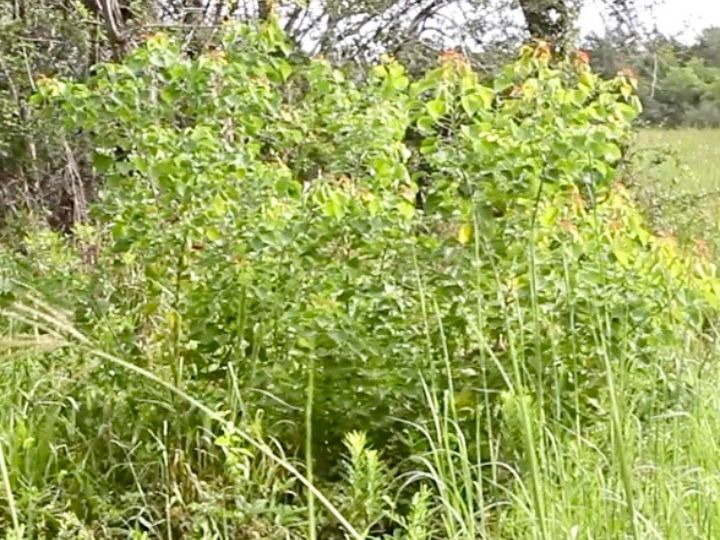

The tallow tree, once considered a popular quick-growing tree that provided much-needed shade to Houston homes due to its fast growth, is being targeted for removal at the University of Houston Coastal Center.
A helicopter sprays herbicide over a stretch of tallow trees at the University of Houston Coastal Center in fall 2022. Aerial spraying, a first for the UH Coastal Center, was used to target invasive tallow trees as part of a process to reform the landscape to its native coastal prairie setting.
The UH Coastal Center, located in La Marque, Texas, is home to many native species of coastal prairie plants and is regarded as one of the highest quality prairies in the nation. Its mission is to support environmental education, research and service on the Texas coast by providing access to field sites, equipment and facilities. The facility has been designated by the Texas Legislature as the home of the Texas Institute for Coastal Prairie Research and Education and is the only field station owned by UH.
The tallow, which is not native to the U.S., is considered invasive throughout the southeastern U.S. and has gradually become the UH Coastal Center’s dominant exotic species over the years. The uncontrolled tallow growth has replaced native prairie species in areas that could be restored to coastal prairie.
Currently, about 190 acres at the UH Coastal Center are actively managed as coastal prairie habitat. A recent aerial spraying project had the goal to increase that number.
“Cutting, mowing and even burning it outright are not effective,” said Evelyn Merz, program director for the UH Coastal Center. “Aerial spraying can be the most efficient way to control this problem.”
Merz also pointed out how the closely packed tallow trees on the property provided the perfect opportunity for aerial spraying.
“Aerial spraying is very effective when you have an extremely dense, closely packed stand of tall trees that can’t be reached from the ground,” said Merz.
Aerial Spraying Targets Tallow Trees
The UH Coastal Center organized its first aerial spraying of tallow trees in fall 2022. “It’s more economical for dense stands of tallow, and a ground crew would not be able to spray the targeted area,” said Merz.
The tallow tree, an exotic invasive species, is encroaching on the native prairie at the UH Coastal Center. Crews are targeting the removal of these trees to restore the center’s native coastal prairie landscape.
With the aid of a helicopter, it took only about an hour to spray 100 acres of densely packed tallow trees. Guided by GPS technology, the helicopter pilot sprayed an herbicide, known for its effectiveness in treating tallow trees, in a precise manner while avoiding unnecessary spraying of adjacent plants.
The herbicide, known as Imox, was applied at the UH Coastal Center at a low level of concentration. It is proven to have a high kill rate for tallow and has previously been used at state parks in the region. It has also been recommended as safe in aquatic habitats and for wildlife and forage.
Restoring the Coastal Prairie Landscape
Aerial spraying is the first step in the process to control the tallow tree on the UH Coastal Center’s 100 acres. The next step will be mechanical mulching and ground crews treating woody brush that was not affected by the herbicide.
“Coastal prairie restoration is not a single event; it is a process because every step that you take affects what’s on the ground and informs you what needs to be done next,” said Merz.
As the tallow and woody brush are removed, this allows sunlight to penetrate to the ground to promote growth of native vegetation on the prairie. Any re-sprouting of invasive vegetation will be treated with herbicide. When there is sufficient dry vegetation to serve as fuel, it will be time for a prescribed burn.
“The goal is to build up the quality of the prairie,” said Merz.
Once the tallow is removed, maintenance will include regular mowing, prescribed burning and selective spot herbicide treatment from the ground.
Merz said while they are making progress, additional work must be done.
“It could take up to three years to get to the point of mowing and spot herbicide treatment,” said Merz. “It depends on the severity of the tallow invasion.”
The results of aerial spraying of herbicide in the fall will not be known until the spring when the tallow sprouts new leaves. “We’ll know the effectiveness for sure at that time if the trees don’t sprout new leaves,” said Merz.
Aerial tallow spraying at the UH Coastal Center was made possible through a cooperative grant from the U.S. Fish and Wildlife Service which was given to Ducks Unlimited with additional assistance of a grant from CITGO Petroleum Corporation.
By Chris Guillory